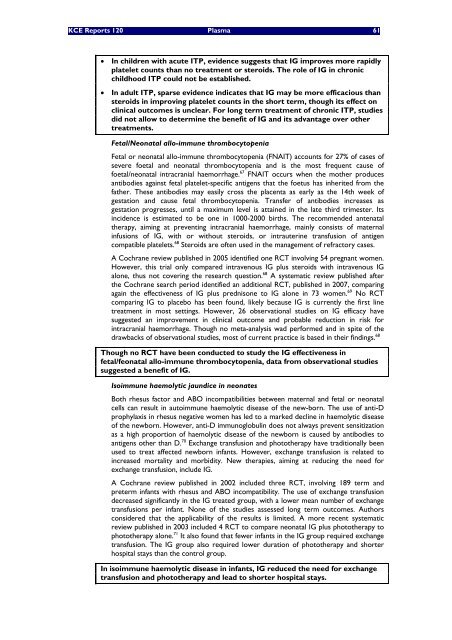The report is available in English with a French summary - KCE
The report is available in English with a French summary - KCE
The report is available in English with a French summary - KCE
Create successful ePaper yourself
Turn your PDF publications into a flip-book with our unique Google optimized e-Paper software.
<strong>KCE</strong> Reports 120 Plasma 61<br />
• In children <strong>with</strong> acute ITP, evidence suggests that IG improves more rapidly<br />
platelet counts than no treatment or steroids. <strong>The</strong> role of IG <strong>in</strong> chronic<br />
childhood ITP could not be establ<strong>is</strong>hed.<br />
• In adult ITP, sparse evidence <strong>in</strong>dicates that IG may be more efficacious than<br />
steroids <strong>in</strong> improv<strong>in</strong>g platelet counts <strong>in</strong> the short term, though its effect on<br />
cl<strong>in</strong>ical outcomes <strong>is</strong> unclear. For long term treatment of chronic ITP, studies<br />
did not allow to determ<strong>in</strong>e the benefit of IG and its advantage over other<br />
treatments.<br />
Fetal/Neonatal allo-immune thrombocytopenia<br />
Fetal or neonatal allo-immune thrombocytopenia (FNAIT) accounts for 27% of cases of<br />
severe foetal and neonatal thrombocytopenia and <strong>is</strong> the most frequent cause of<br />
foetal/neonatal <strong>in</strong>tracranial haemorrhage. 67 FNAIT occurs when the mother produces<br />
antibodies aga<strong>in</strong>st fetal platelet-specific antigens that the foetus has <strong>in</strong>herited from the<br />
father. <strong>The</strong>se antibodies may easily cross the placenta as early as the 14th week of<br />
gestation and cause fetal thrombocytopenia. Transfer of antibodies <strong>in</strong>creases as<br />
gestation progresses, until a maximum level <strong>is</strong> atta<strong>in</strong>ed <strong>in</strong> the late third trimester. Its<br />
<strong>in</strong>cidence <strong>is</strong> estimated to be one <strong>in</strong> 1000-2000 births. <strong>The</strong> recommended antenatal<br />
therapy, aim<strong>in</strong>g at prevent<strong>in</strong>g <strong>in</strong>tracranial haemorrhage, ma<strong>in</strong>ly cons<strong>is</strong>ts of maternal<br />
<strong>in</strong>fusions of IG, <strong>with</strong> or <strong>with</strong>out steroids, or <strong>in</strong>trauter<strong>in</strong>e transfusion of antigen<br />
compatible platelets. 68 Steroids are often used <strong>in</strong> the management of refractory cases.<br />
A Cochrane review publ<strong>is</strong>hed <strong>in</strong> 2005 identified one RCT <strong>in</strong>volv<strong>in</strong>g 54 pregnant women.<br />
However, th<strong>is</strong> trial only compared <strong>in</strong>travenous IG plus steroids <strong>with</strong> <strong>in</strong>travenous IG<br />
alone, thus not cover<strong>in</strong>g the research question. 68 A systematic review publ<strong>is</strong>hed after<br />
the Cochrane search period identified an additional RCT, publ<strong>is</strong>hed <strong>in</strong> 2007, compar<strong>in</strong>g<br />
aga<strong>in</strong> the effectiveness of IG plus predn<strong>is</strong>one to IG alone <strong>in</strong> 73 women. 69 No RCT<br />
compar<strong>in</strong>g IG to placebo has been found, likely because IG <strong>is</strong> currently the first l<strong>in</strong>e<br />
treatment <strong>in</strong> most sett<strong>in</strong>gs. However, 26 observational studies on IG efficacy have<br />
suggested an improvement <strong>in</strong> cl<strong>in</strong>ical outcome and probable reduction <strong>in</strong> r<strong>is</strong>k for<br />
<strong>in</strong>tracranial haemorrhage. Though no meta-analys<strong>is</strong> wad performed and <strong>in</strong> spite of the<br />
drawbacks of observational studies, most of current practice <strong>is</strong> based <strong>in</strong> their f<strong>in</strong>d<strong>in</strong>gs. 68<br />
Though no RCT have been conducted to study the IG effectiveness <strong>in</strong><br />
fetal/feonatal allo-immune thrombocytopenia, data from observational studies<br />
suggested a benefit of IG.<br />
Isoimmune haemolytic jaundice <strong>in</strong> neonates<br />
Both rhesus factor and ABO <strong>in</strong>compatibilities between maternal and fetal or neonatal<br />
cells can result <strong>in</strong> autoimmune haemolytic d<strong>is</strong>ease of the new-born. <strong>The</strong> use of anti-D<br />
prophylax<strong>is</strong> <strong>in</strong> rhesus negative women has led to a marked decl<strong>in</strong>e <strong>in</strong> haemolytic d<strong>is</strong>ease<br />
of the newborn. However, anti-D immunoglobul<strong>in</strong> does not always prevent sensitization<br />
as a high proportion of haemolytic d<strong>is</strong>ease of the newborn <strong>is</strong> caused by antibodies to<br />
antigens other than D. 70 Exchange transfusion and phototherapy have traditionally been<br />
used to treat affected newborn <strong>in</strong>fants. However, exchange transfusion <strong>is</strong> related to<br />
<strong>in</strong>creased mortality and morbidity. New therapies, aim<strong>in</strong>g at reduc<strong>in</strong>g the need for<br />
exchange transfusion, <strong>in</strong>clude IG.<br />
A Cochrane review publ<strong>is</strong>hed <strong>in</strong> 2002 <strong>in</strong>cluded three RCT, <strong>in</strong>volv<strong>in</strong>g 189 term and<br />
preterm <strong>in</strong>fants <strong>with</strong> rhesus and ABO <strong>in</strong>compatibility. <strong>The</strong> use of exchange transfusion<br />
decreased significantly <strong>in</strong> the IG treated group, <strong>with</strong> a lower mean number of exchange<br />
transfusions per <strong>in</strong>fant. None of the studies assessed long term outcomes. Authors<br />
considered that the applicability of the results <strong>is</strong> limited. A more recent systematic<br />
review publ<strong>is</strong>hed <strong>in</strong> 2003 <strong>in</strong>cluded 4 RCT to compare neonatal IG plus phototherapy to<br />
phototherapy alone. 71 It also found that fewer <strong>in</strong>fants <strong>in</strong> the IG group required exchange<br />
transfusion. <strong>The</strong> IG group also required lower duration of phototherapy and shorter<br />
hospital stays than the control group.<br />
In <strong>is</strong>oimmune haemolytic d<strong>is</strong>ease <strong>in</strong> <strong>in</strong>fants, IG reduced the need for exchange<br />
transfusion and phototherapy and lead to shorter hospital stays.

















